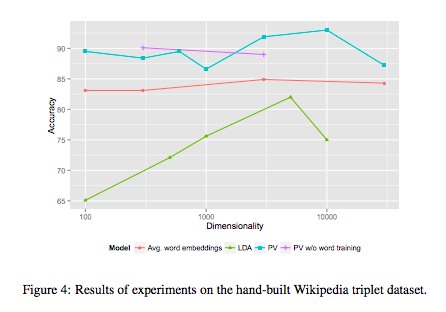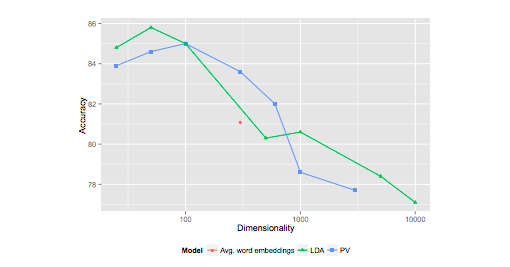Presented at NIPS 2014 (PDF) by Dai, Olah, Le and Corrado.
Model
The authors consider a modified version of the PV-DBOW paragraph vector model. In previous work, PV-DBOW had distinguished words appearing in the context window from non-appearing words given only the paragraph vector as input. In this modified version, the word vectors and the paragraph vectors take turns playing the role of the input, and word vectors and paragraph vectors are trained together. That is, a gradient update is performed for the paragraph vector in the manner of regular PV-DBOW, then a gradient update is made to the word vectors in the manner of Skipgram, and so on. This is unfortunately less than clear from the paper. The authors were good enough to confirm this via correspondence, however (thanks to Adriaan Schakel for communicating this). For the purposes of the paper, this is the paragraph vector model.
The representations obtained from paragraph vector (using cosine similarity) are compared to those obtained using:
- an average of word embeddings
- LDA, using Hellinger distance (which is proportional to the L2 distance between the component-wise square roots)
- paragraph vector with static, pre-trained word vectors
In the case of the average of word embeddings, the word vectors were not normalised prior to taking the average (confirmed by correspondence).
Corpora
Two corpora are considered, the arXiv and Wikipedia:
- 4.5M articles from Wikipedia, with a vocabulary of size 915k
- 886k articles from the arXiv, full texts extracted from the PDFs, with a vocabulary of 970k words.
Only unigrams are used. The authors observed that bigrams did not improve the quality of the paragraph vectors. (p3)
Quantitative Evaluation
Performance was measured against collections of triples, where each triple consisted of a test article, an article relevant to the test article, and an article less relevant to the test article. While not explicitly stated, it is reasonable to assume that the accuracy is then taken to be the rate at which similarity according to the model coincides with relevance, i.e. the rate at which the model says that the relevant article is more similar than the less relevant article to the test article. Different sets of triples were considered, the graph below shows performance of the different methods relative to a set of 172 Wikipedia triples that the authors built by hand (these remain unreleased at the time of writing).
It is curious that, with the exception of the averaged word embeddings, the accuracy does not seem to saturate as the dimension increases for any of the methods. However, as each data point is the accuracy of a single training (confirmed by correspondence), this is likely nothing more than the variability inherent to each method. It might suggest, for example, that the paragraph vectors method has a tendency to get stuck in local minima. This instability in paragraph vector is not apparent, however, when tested on the triples that are automatically generated from Wikipedia (Figure 5). In this latter case, there are many more triples.
Performance on the arXiv is even more curious: accuracy decreases markedly as the dimension increases!
Implementations
I am not sure there are any publicly available implementations of this modified paragraph vectors method. According to Dai, the implementation of the authors uses Google proprietary code and is unlikely to be released. However it should be simple to modify the word2vec code to train the paragraph vectors, though some extra code will need to be written to infer paragraph vectors after training has finished.
I believe that the gensim implementation provides only the unmodified version of PV-DBOW, not the one considered in this paper.
Comments
It is interesting that the paragraph vector is chosen so as to best predict the constituent words, i.e. it is inferred. This is a much better approach from the point of view of word sense disambiguation than obtaining the paragraph vector as a linear image of an average of the word vectors (NMF vs PCA, in their dimension reductions on bag of words, is another example of this difference).
Thanks to Andrew Dai and Adriaan Schakel for answering questions!
Questions
- Is there is an implementation available in GenSim? (see e.g. this tutorial).
- (Tangent) What is the motivation (probabilistic meaning) for the Hellinger distance?

